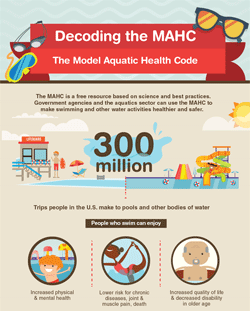Updated CDC Guidance for Healthy Pools
 Government agencies and the aquatics industry can use updated pool code guidance to help keep swimming healthy and fun.
Government agencies and the aquatics industry can use updated pool code guidance to help keep swimming healthy and fun.
Few things are more refreshing than a swim in a cool, clear pool on a sweltering hot day. Swimming is an excellent form of exercise: it is low impact on the joints, naturally incorporates resistance training, and allows you to stay cool while getting your heart pumping.
At the request of local and state health departments and the aquatics industry, CDC led a national effort to develop a Model Aquatic Health Code (MAHC) to maintain swimming’s perks while reducing dangers that can occur at pools and other aquatic venues. The MAHC was first released in 2014, and CDC released the second edition (the 2016 MAHC) in July 2016. From the beginning, CDC committed to keeping the MAHC up to date with the latest science and industry practices.
What is the MAHC?
The MAHC is a free resource to make swimming healthier. It is a set of voluntary guidelines, not a federal law. This means government agencies can choose to adopt none, some, or all of it. They can use it to:
- Create or update existing pool codes.
- Incorporate the latest science into their pool inspection and safety programs.
Aquatics industry leaders don’t have to wait for a government agency to adopt the MAHC. They can implement key MAHC elements now to start improving health and safety at their facilities.
What is in the MAHC?
The MAHC includes science-based guidelines for:
- Public swimming pools
- Pools, hot tubs, and spas in hotels and apartment complexes
- Waterparks
- Other aquatic facilities
The guidelines address:
- Design and construction, such as secondary disinfection systems to kill chlorine-tolerant organisms and reduce outbreaks.
- Operations and maintenance, such as lifeguarding standards to reduce drowning.
- Policies and management, such as training for pool operators to reduce pool chemical accidents, pool closures, and other issues.
The MAHC also includes a summary of the scientific rationale for each guideline.

Use the MAHC to help reduce dangers at pools.
What’s New?
The 2016 MAHC includes structural changes, clarifying edits, and new or revised provisions in the areas of disinfection and water quality, lifeguarding and bather supervision, risk management and safety, and ventilation and air quality. What you’ll find on the MAHC website:
- The 2016 MAHC, including model code language and annex with scientific rationale for provisions
- A summary of key changes and a track changes version with line-by-line edits
- A MAHC-based inspection form
- Updated tool to help you compare your pool code and practices to those the MAHC recommends and
- Updated MAHC infographic, factsheet, and other health promotion materials
What are the benefits of the MAHC?
Benefits of using the MAHC are that it’s free, voluntary, and science based. In the short term, it may help reduce pool closures. Longer term, CDC expects that the MAHC could drive reductions in:
- Drowning, a leading cause of injury-related death for children 1-14 years. Non-fatal drowning can cause brain damage resulting in learning disabilities or even permanent loss of basic functioning.
- Waterborne illness outbreaks associated with pools and other aquatic facilities, which have increased from an average of 15 outbreaks a year to 34. A single outbreak can sicken thousands.
- Injuries linked with pool chemicals, which accounted for nearly 5,000 emergency department visits in 2012.
More Information
More Information
Want to learn more? Visit these sites for more information:
- Page last reviewed: July 18, 2016
- Page last updated: July 18, 2016
- Content source:
- National Center for Environmental Health and National Center for Emerging and Zoonotic Infectious Diseases
- Page maintained by: Office of the Associate Director for Communication, Digital Media Branch, Division of Public Affairs




 ShareCompartir
ShareCompartir
